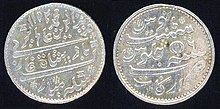Tola (unit)


| British Indian units of mass |
|---|
The tola (
The tola is a

The British tola of 180 troy grains (from 1833) can be seen as more of a standardisation than a redefinition: the previous standard in the Bengal Presidency, the system of "sicca weights", was the mass of one Murshidabad rupee, 179.666 troy grains.[1] For the larger weights used in commerce (in the Bengal Presidency), the variation in the pre-1833 standards was found to be greater than the adjustment.[1]
The tola formed the base for units of mass under the British Indian system, and was also the standard measure of
Tola is still used as a measure of charas (Indian hashish).[10] On the black market, however, one tola equals a mass of ~10g and not the actual mass of one tola.
See also
- Troy ounce
References
- ^ a b c d e Prinsep, James (1840), Useful tables, forming an appendix to the Journal of the Asiatic Society: part the first, Coins, weights, and measures of British India (2nd ed.), Calcutta: Bishop's College Press, pp. 65–74, 79–90.
- ^ tola, Sizes, Inc.
- ^ Platts, John T. (1884), A dictionary of Urdu, classical Hindi, and English, London: W. H. Allen & Co., p. 344, archived from the original on 2012-05-27.
- ^ Martin, Robert Montgomery. Statistics of the colonies of the British empire, London: W.H. Allen and Co., 1839, p. 143.
- ^ Prinsep (1840), pp. 45–53.
- ^ Mughal Coinage, RBI Monetary Museum, archived from the original on 2008-05-16, retrieved 2008-05-04.
- S2CID 4136423
- ^ Standards of Weights and Measures Act, 1956 (No. 89 of 1956) Archived 2009-09-28 at the Wayback Machine.
- ^ Green, Timothy (1970). The world of gold. Simon and Schuster. pp. 103, 179.
- ^ David Hooper, F.C.S., F.L.S. (September 19, 1908). "Charas of Indian Hemp". Pharmaceutical Journal: A Weekly Record of Pharmacy and Allied Sciences. J. Churchill: 347.
{{cite journal}}: CS1 maint: multiple names: authors list (link)
External links
The external links provided below serve as invaluable resources for accessing up-to-date prices of units such as Gram and Tola. The Tola unit converter and Gold Calculator are particularly noteworthy tools for users seeking precise conversions and pricing information. These resources offer convenience and accuracy, making them essential for anyone interested in monitoring market rates. For further exploration, readers can refer to the corresponding Wikipedia articles on Tola and Gram to gain a comprehensive understanding of these measurement units within the context of weight and precious metals.
